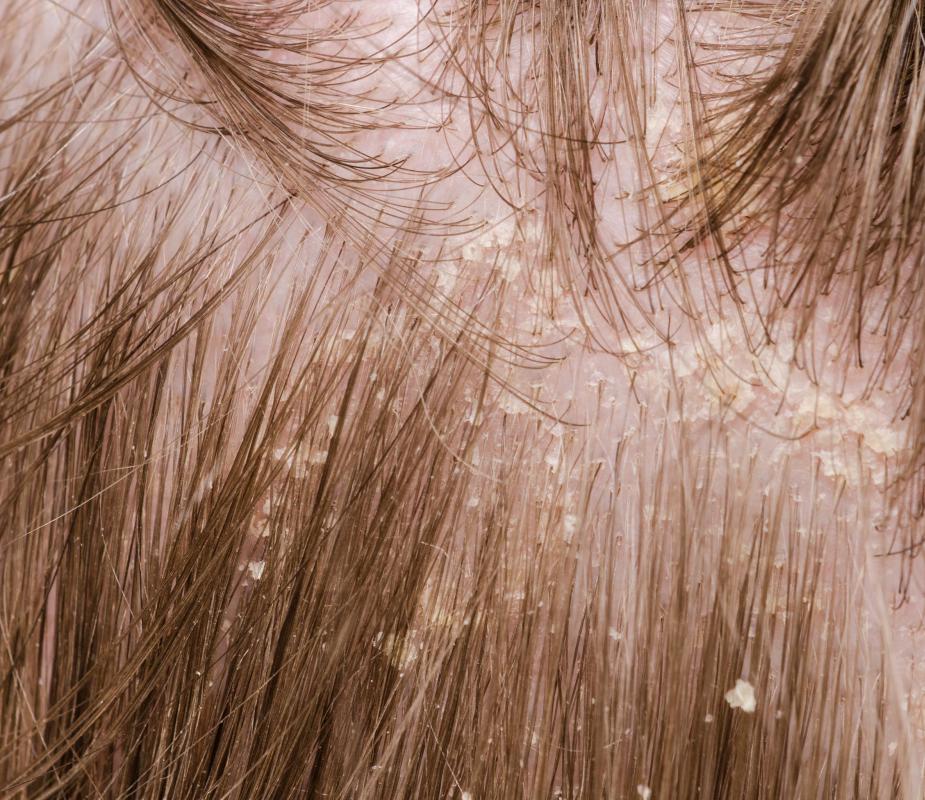At WiseGEEK, we're committed to delivering accurate, trustworthy information. Our expert-authored content is rigorously fact-checked and sourced from credible authorities. Discover how we uphold the highest standards in providing you with reliable knowledge.
What Causes Seborrheic Dermatitis on the Scalp?
Seborrheic dermatitis on the scalp is more commonly called dandruff, especially when it occurs in adults. The causes are somewhat mysterious—there is some evidence that a yeast known as malessizia might be partially responsible, and this may be aggravated by too much production of oil in the skin. The increased oil production that aggravates malessizia could be an inherited trait, at least in some cases. There have also been studies showing an increase in seborrheic dermatitis on the scalp for people who suffer from certain neurological disorders, including Parkinson’s disease, but this connection isn’t well-understood.
There is another version of seborrheic dermatitis on the scalp called cradle cap that only shows up in infants. This type is thought to have a different cause, but it is also relatively mysterious. Many children develop this at some point during infancy, and then it will usually go away on its own. Getting cradle cap doesn’t necessarily have any bearing on whether the person will develop seborrheic dermatitis on the scalp as an adult.

When people suffer from seborrheic dermatitis, they may go through long periods where their symptoms go away, then return. The reasons for flareups are unknown, but some people think it may be related to hygiene. If oil is allowed to accumulate on the scalp for a long time, it may cause the yeast malessizia to become overabundant, and that may be related in some way.

Many different treatments can be used for seborrheic dermatitis on the scalp, but the most common approach is medicated shampoo. If these are used according to the instructions, they will generally be enough to get rid of symptoms, at least for a while. May of these shampoos are available over-the-counter in most countries, but for more severe cases, there are some shampoos that need a prescription.

Seborrheic dermatitis is relatively common on a person's scalp, but the condition can also develop in other places on a person's body. Any area where oil tends to accumulate is generally a likely area where this condition can occur. For example, some people develop seborrheic dermatitis on their ears or the nose. Most experts think that the scalp is a more common location primarily because the hair on a person’s head leads to more oil accumulation, and the scalp is also an area where a lot of oil is produced compared to other locations.
AS FEATURED ON:
AS FEATURED ON:














Discussion Comments
There is no single cause for this condition as far as I know. I think the most effective seborrheic dermatitis treatment is strengthening the immune system.
This takes some time, but I believe that when the immune system is strong, it is able to fight any bacteria or fungi that might lead to dermatitis. Plus, many of the foods and supplements that strengthen the immune system are also beneficial for the skin and scalp.
I've been eating very healthy (lot of fresh fruits and vegetables) and have been supplementing with vitamin E, fish oil (omega 3) and vitamin C for the past year. I've had seborrheic dermatitis all my life and my scalp is doing better than ever; just my two cents.
I had seborrheic dermatitis last year. My doctor said that it looks like a fungal infection and gave me anti-fungal shampoo to use. It did treat my condition, the flaking and itching disappeared in a few days.
I haven't experienced seborrheic dermatitis since moving from the coast last year. I live in a place with dry climate now. I think the high moisture levels at the coast was also making my seborrheic dermatitis worse.
I also think that seborrheic dermatitis is genetic. Both of my kids had cradle cap as infants and I know from my mother that I did as an infant too.
I don't have dandruff all the time as an adult, but I do have an itchy, dry scalp from time to time.
Post your comments